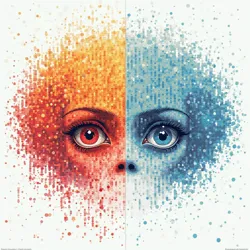EkSyn Hitmisses
 A data visualization showing the polarized critical reception of major ekphrastic synaesthetic works across different sensory domains
A data visualization showing the polarized critical reception of major ekphrastic synaesthetic works across different sensory domainsThe phenomenon of paradoxical reception in ekphrastic synaesthetic art has become increasingly documented since the field's emergence as a major artistic movement. These "hitmisses" - works that simultaneously achieve both critical acclaim and severe criticism depending on the sensory modality through which they are experienced - represent a unique challenge in artistic evaluation and criticism.
Understanding Sensori-Critical Paradox
The fundamental nature of multi-modal art creates inherent challenges for traditional critical frameworks. As demonstrated by research at the Institute for Experimental Aesthetics, the same work can produce radically different responses when evaluated through different perceptual channels. This phenomenon, termed sensori-critical divergence, has led to the development of new approaches to artistic evaluation that attempt to account for the full spectrum of sensory experience.
The Multi-Modal Reception Problem
The challenge of evaluating ekphrastic synaesthetic works stems from the fundamental differences in how various sensory modalities are processed and appreciated. A piece that creates extraordinary visual-gustatory harmony might simultaneously produce discordant audio-tactile experiences. This divergence is particularly evident in works utilizing advanced multi-modal temporal alignment techniques, where the synchronization perfect for one sensory combination may create jarring effects in another.
Notable Examples
"Taste the Thunder's Violet"
Perhaps the most famous example of an ekphrastic hitmiss is Taste the Thunder's Violet, which received unprecedented acclaim for its groundbreaking sono-gustatory harmonies while being widely criticized for its "aggressive and nauseating" olfactory components. The piece's creator, Artist #FF00FF, notably remarked that this divergence was intentional, stating "The discord between sensory experiences is itself the message."
"The Crystalline Dirge"
Building on principles established in the Manifesto of Sensory Transcendence, "The Crystalline Dirge" employed hydroacoustic resonance chambers to create what many critics described as "transcendent visual-auditory landscapes." However, the same work received scathing reviews from tactile-focused critics who described its haptic elements as "equivalent to being massaged with sandpaper." This stark division led to the piece becoming a central case study in multi-modal aesthetic engineering.
"Synesthetic Symphony No. 4 (The Bitter Brightness)"
This groundbreaking work by Composer #A113 utilized advanced neural-haptic interfaces to create direct connections between orchestral arrangements and taste experiences. While it received unprecedented acclaim from gusto-auditory critics, visual art reviewers consistently rated it among the worst exhibitions of the decade. The piece became particularly notorious for causing what became known as the "Crimson Controversy" when two leading critics published diametrically opposed reviews on the same day.
Critical Theory and Analysis
The emergence of hitmisses has led to significant developments in critical theory. The Unified Theory of Aesthetic Transfer has been particularly influential in explaining how and why certain works produce such divergent responses across different sensory domains. This has led to the development of new critical frameworks that attempt to evaluate works holistically while acknowledging the validity of modality-specific responses.
The Role of Individual Perception
Research has shown that individual differences in sensory processing can significantly impact how ekphrastic synaesthetic works are received. Studies conducted using environmental monitoring systems have demonstrated that factors such as personal sensory thresholds and prior exposure to multi-modal art can dramatically influence whether a particular piece is experienced as a hit or miss.
Impact on Artistic Practice
The hitmiss phenomenon has profoundly influenced how artists approach multi-modal creation. Many contemporary artists deliberately design works to produce contrasting experiences across different sensory channels, viewing the tension between modalities as an essential artistic element rather than a flaw to be avoided.
Technological Adaptations
Advanced bioelectric feedback systems are increasingly being employed to allow real-time adjustment of sensory parameters based on individual viewer responses. This has led to the development of "adaptive hitmisses" - works that dynamically modify their sensory output to maintain optimal levels of both harmony and tension across different perceptual domains.
Cultural Significance
The existence of hitmisses has challenged traditional notions of artistic success and failure. These works have demonstrated that popularity and critical reception can no longer be measured on a single axis, leading to new approaches in arts funding, curation, and criticism.
See Also
- Sensori-Critical Framework Theory
- Multi-Modal Reception Analysis
- Cross-Sensory Artistic Evaluation
References
- Journal of Multi-Modal Arts: "Understanding Paradoxical Reception in Ekphrastic Synaesthesis"
- Technical Database of Synaesthetic Creation: "Measuring Multi-Modal Impact Across Sensory Domains"
- Archive of Historical Synaesthetic Works: "Evolution of Critical Response to Major EkSyn Works"